We want you to throw big parties, tell us about it, and win big (big!) prizes from Le Creuset. (Find out more here.) All week, we've been featuring Emiko Davies as she documents her whole-hog feast, La Maialata.
Today: La Maialiata has arrived! Catch up with her earlier posts, The Butcher Knows Best, Pig's Blood for Dessert, and The Ethics of Eating Offal.
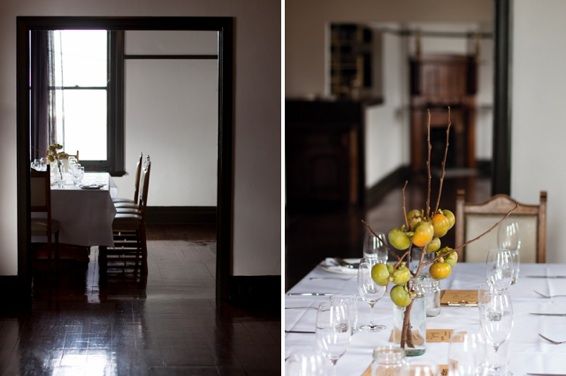
Concocting my ideal dinner party was an easy task: take favourite ingredient (pork) and insert into every dish. Then invite fellow pork enthusiasts, find a suitable location to hold the dinner (our apartment is too tiny for a feast) and let the evening take its course.
The idea then grew, thanks to the help of my Tuscan husband Marco, with whom I share a passion for traditional dishes and offal (amongst other things), to incorporate dishes made with cuts of pork that our Melbourne friends were likely not familiar with. Pretty soon the dinner was nicknamed “La Maialata” (maiale is Italian for pig and ‘maialata’ implies a certain amount of ‘pigging out’). We went over some of our favourite recipes from Tuscany and eventually moved further south to Campania to finally produce a menu inspired by two Italian regions, which actually could not be more different, gastronomically speaking, but which we wanted to bring together in a showing of some of our favourite ways to cook pork. Not every dish features a “less noble” cut, but the ones that do demonstrate just how deliciously Italians cook offal.
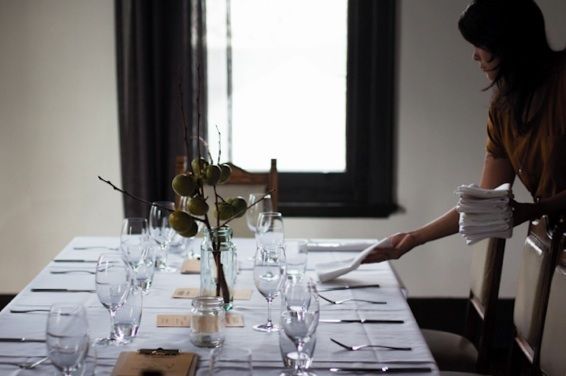
The meat was sourced from three different Melbourne butchers: two of my favourite Italian butchers, Brenta and Donati’s, for the offal and Hagens, an organic and biodynamic butcher for the rare-breed Berkshire pork. All the vegetables came from the organic markets at Melbourne’s lovely Queen Victoria Markets. And because offal and cuts like pork shoulder are so economical and we focused on local ingredients, we managed to keep a five-course meal for 10 people with plenty of wine (an Australian sangiovese) within a very reasonable budget.
The menu was one of Tuscan and southern Italian traditional dishes – not something you would normally eat together in one meal. But we like to think it as a sort of “taster” or degustation of what you can do with different cuts of pork, Italian style. Dishes were served in small-ish portions, moving from ‘lighter’ flavours to heavier ones, so that our guests could happily make it to dessert!
THE PREP
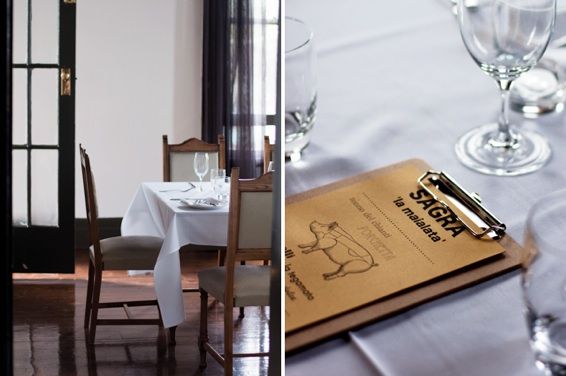
Pigs have traditionally been butchered in the natural refrigeration of winter in Italy, and as a result, many offal dishes are typically cold weather ones that involve long, slow cooking on the hearth. We were able to use this to our advantage as much of the menu had to be done in advance, making the job on the day relatively easy.
This meant in the morning I had time to design the menu, inspired by the bright yellow posters of ‘sagre’ (food festivals) held in Italian country towns. We wanted the dishes to each tell a story to our friends, the story of the tradition or the town where it comes from – these stories were included on the menu, so between courses they could read about what was coming up next.
After preparing what we could that morning, such as Marco’s rosemary schiacciata, we packed everything up and headed over to our dining venue for the night: the Town Hall Hotel, an iconic pub in Fitzroy, one of Melbourne’s oldest suburbs and certainly its most eclectic.
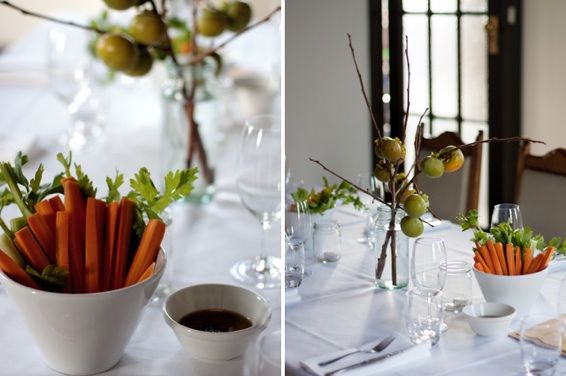
The long wooden table was set with a white tablecloth, a simple centrepiece of young persimmon branches (a hint that it’s the beginning of autumn here in Melbourne) and candles in vintage jars. Glass carafes holding sangiovese, Tuscany’s favourite wine, served as a reminder of the wine by the carafe that you find in traditional Italian trattorie. Bowls of crunchy raw vegetable sticks for pinzimonio, an old-school Italian pre-dinner favourite, were placed along the centre of the table. Dipped simply in small ramekins of extra virgin olive oil seasoned with sea salt, black pepper and a dash of balsamic vinegar, pinzimonio not only makes a great aperitivo (the idea being that it ‘opens up your stomach’ and enhances your appetite, helping you get ready for the feast to come) but also serves as a palate-cleanser.
IT ALL STARTS HERE: TONNO DEL CHIANTI
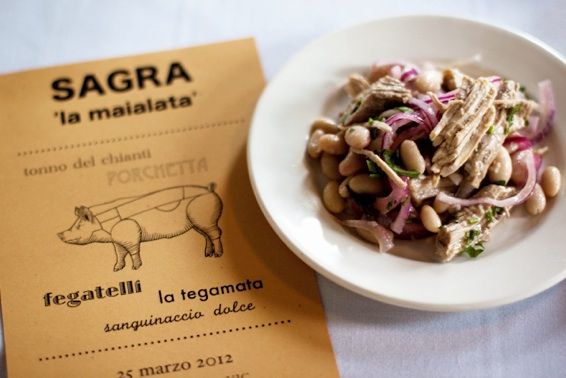
Our entrée featured one of my favourite cuts of pork, the shoulder (also known confusingly as a Boston butt). It’s a brilliant piece of meat that costs next to nothing and becomes extremely tender when slow cooked, hence its use in pulled pork recipes.
We used it to make a Tuscan specialty known as tonno del chianti (“tuna from the Chianti”, a rather misleading name). It’s cooked in an entire bottle of white wine for hours until it falls apart just by looking at it. The result is delicate, shredded, soft meat that appears similar to canned tuna. It’s an unusual preparation of pork that was a logical answer to the problems Tuscan farmers faced when needing to butcher a pig outside of the winter season, pre-refrigeration age. After roughly shredding the shoulder into pieces, the meat is bottled in olive oil with bay leaf, peppercorns and juniper berries. If you don’t devour it all at once, it is meant to keep for a year.
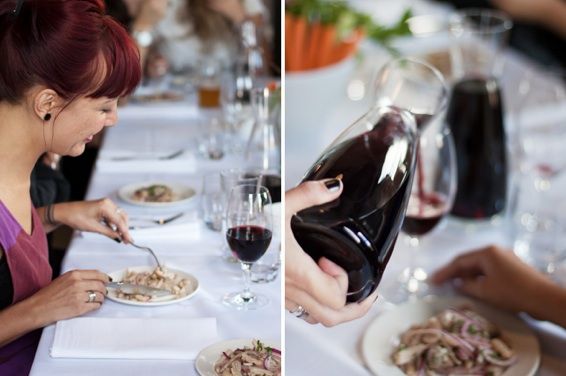
It’s normally served very simply, alone with bread. Because of its namesake, we prepared it as a popular Tuscan salad that you’d normally find made with tuna, where it is tossed together with white cannellini beans and finely sliced red onion, dressed simply in lemon and olive oil.
A TASTE OF STREET FOOD: PANINO CON PORCHETTA
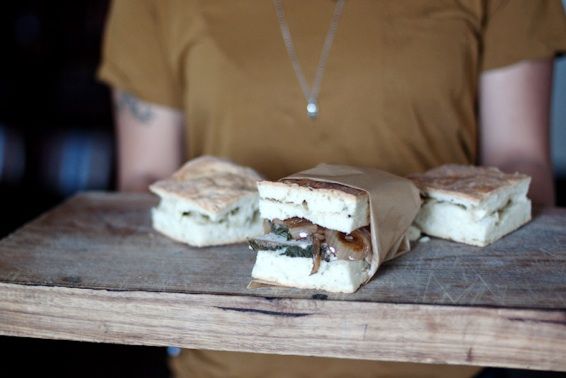
The next course was a panino con porchetta, a delectable specialty of central Italy where you find these made-to-order panini sold from stalls or food vans at fairs, markets and festivals. Traditionally, porchetta is a whole boned, roasted young pig, seasoned with garlic, herbs and wild fennel and roasted in a wood-fired oven. It is usually cut into huge slices and served simply on schiacciata (focaccia bread).
We’ve taken the porchetta idea but on a mini-scale, with what might be more technically speaking, arista: a Florentine specialty of a lean cut of loin, roasted with plenty of garlic and rosemary and eaten cold, sliced.

We sourced our pork loin from the rare breed McIvor Farm in Tooborac, about an hour north of Melbourne. The farm raises organic, free-range black Berkshire pigs on wide open paddocks. Berkshires are said to be Britain’s oldest pigs but are today in dwindling numbers, at risk of disappearing completely if it weren’t for an interest in rare breed specialty farming (take note, unlike, say endangered animals, which obviously aren’t meant to be eaten, eating rare breed pork means supporting the farms that endeavour to keep these breeds going). The meat is juicy, tender and unbelievably flavoursome with plenty of marbling, so it is suited to long cooking, which we did the night before.
We served our ‘porchetta’ with cipolline in agrodolce (pearl onions cooked in a sweet vinegar sauce), a favourite Tuscan side dish to accompany roasts, on Marco’s rosemary schiacciata, made that morning while I was busy preparing the menus. The panini were presented individually wrapped in unbleached recycled parchment paper on a wooden board, for easy eating with hands, a little nod to the dish’s street food origins.
RAVIOLONI FILLED WITH BRAISED PORK CHEEKS
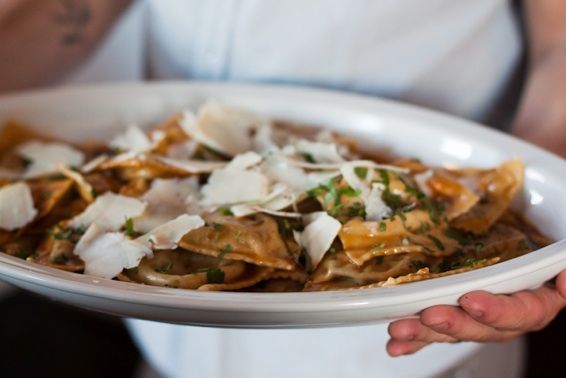
Pork cheeks are so underrated and in my opinion the best place to start for an offal-virgin. Cheap and forgivingly easy to cook, this delicious, fall-apart meat makes fantastic ragu or stew. Italians also cure pork cheeks for guanciale – a tastier-than-bacon product and the essential ingredient in a proper Roman carbonara. We wanted to use fresh pork cheeks to make a dish known as Tegamata, which we tasted when we witnessed our first pig butchering on a friend’s organic farm in San Gimignano.
Traditionally, the Tegamata is cooked in terracotta on a fireplace. The pork cheek is chopped roughly into chunks and cooked for hours with rosemary and sage. We decided that the delicious, fall-apart meat would make a beautiful filling for ravioloni (large ravioli), so we strained the stew, kept the meat for the filling, and reserved the rest of the sauce for the final finish.
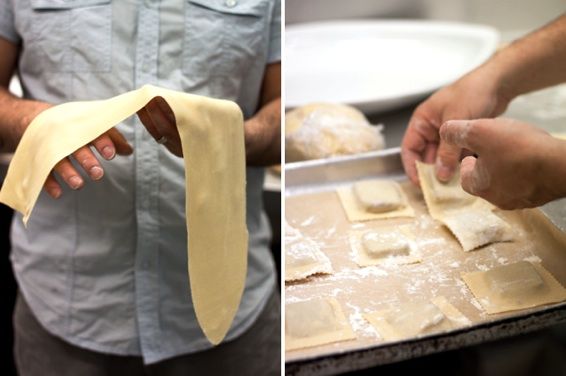
About an hour before our guests arrived, Marco whipped up some fresh egg pasta, rolled it out into thin, wide sheets and we filled our ravioloni – really the only major prep we had to do on the day. I am so glad we had a large kitchen for this; the bench space and huge boiling pots of water were very much welcomed!
We served the ravioloni on a large platter for people to help themselves. The cheeks are another cut of meat that melt down into incredibly soft and tender pieces with slow cooking, even more so than the shoulder, making a rich, silky, ever so sticky and unbelievably tasty stew. Not a single drop of the sauce was wasted, our guests even used pieces of bread to partake of that favourite Italian habit, the scarpetta, to sop up the sticky sauce.
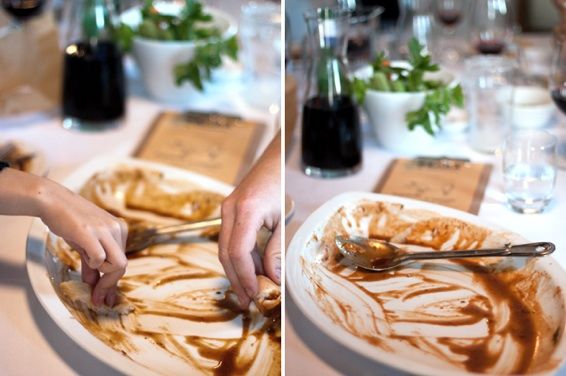
FEGATELLI: PORK LIVER WITH FENNEL SEEDS
Our last dish of the dinner was another one that we knew right away we would make – it is Marco’s favourite. Pork liver is generally less commonly used than veal liver, some say it has a stronger flavour. Tuscans have a thousand different versions of this rustic country dish of fegatelli; each town has their own recipe. In Siena, they mince up the liver and make little balls, held together in the lacy bodice-like encasing of caul fat, which are then roasted in lard. In some places, it’s grilled or roasted on a skewer with alternate pieces of lean pork and bread.

We do it the way that you find it in Fucecchio, the town where Marco’s family live: whole, golf-ball sized chunks of liver, flavoured simply with fennel seeds and wrapped in caul fat before being roasted. But we added a little extra touch that we found in the 1920’s Roman cookbook writer Ada Boni’s Talismano della Felicita (The Talisman of Happiness, such a wonderful name for a cookbook), where the fennel seeds are pounded with breadcrumbs and garlic and the liver is rolled in this mixture before being wrapped up in caul fat and roasted until still blushing pink inside. Just before serving, the fegatelli were popped into a hot skillet with some olive oil to get a bit of golden-brown caramelisation and served with a shaved fennel salad to cut through the richness of the liver.
THE FINAL TOUCH: GELATO OF SANGUINACCIO DOLCE AND FIOR DI LATTE AL ROSMARINO
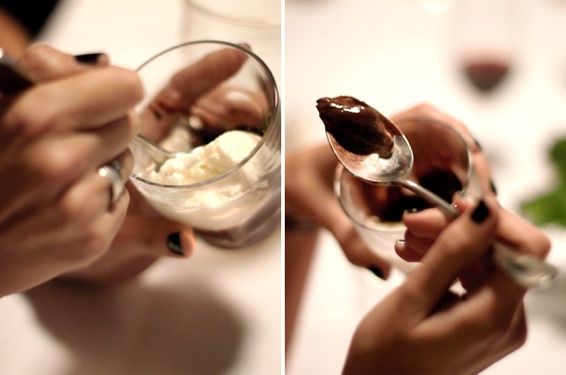
This was the dish that everyone was eagerly waiting for. The idea of eating blood, as a main ingredient in a decadent, chocolatey dessert, just brought out the blood-lusting vampire in everyone.
Sanguinaccio dolce is an old southern Italian specialty of fresh pig’s blood, mixed with dark chocolate and milk into a decadent pudding, a dying tradition now in Italy since the 1992 Italian law banning the sale of pig’s blood.
We thought the custard-like consistency of the salty-sweet sanguinaccio dolce was suited to making into gelato (just cool and put it straight into an ice-cream maker). To accompany it, we also made a gelato di fior di latte al rosmarino. Fior di latte is the simplest gelato in the world: a mixture of milk and cream with sugar (no eggs). We infused the milk with a few sprigs of rosemary to add a bit of herby savouriness that we hoped would match the sanguinaccio. It was unanimously everyone’s favourite dish of the night.
THE VERDICT

It was a true celebration of the pig via some of our favourite (and newly discovered) traditional regional Italian recipes – and I don’t think it will be the last. There are still a few more dishes we had in mind that could easily fill up a menu for La Maialata ‘Part Two’, including a Roman recipe for pork heart soup and Sardinian porceddu (whole roast suckling piglet) – but it’ll be hard to find another pig dessert that will top the excitement and reactions to the sanguinaccio dolce gelato.
Le Creuset has generously offered to reward our Big Feasters for all their hard work, and as our second Big Feast, Emiko will win, in the color of her choice (flame, cherry, fennel, Caribbean, or Marseille): a 3 1/2-quart round French oven, a 9-inch iron handle skillet, and a 1 1/4-quart precision pour pan. Pitch us your Big Feast at [email protected] for a chance to win up to $500 in Le Creuset booty.
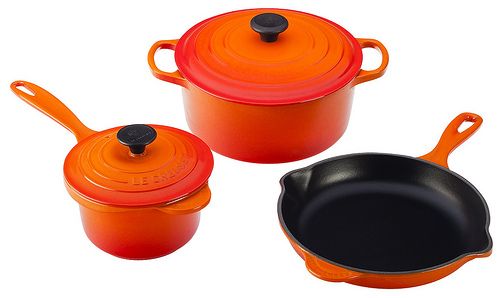
















See what other Food52 readers are saying.